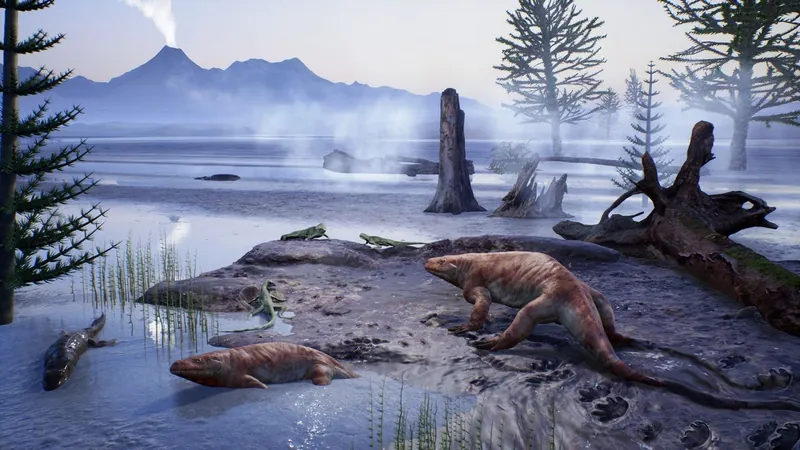
Hiker Unveils Ancient 280 Million-Year-Old Ecosystem Hidden in the Italian Alps!
2024-11-19
Author: Olivia
A Stunning Discovery
In a stunning twist of fate, Claudia Steffensen, an avid hiker, stumbled upon an extraordinary discovery while exploring the breathtaking Valtellina Orobie Mountains Park in Lombardy, Italy. During a routine trek with her husband in 2023, Steffensen stepped on what seemed to be a mere rock, but it turned out to be a fragment of a 280 million-year-old ecosystem, bursting with ancient footprints, plant fossils, and even the fascinating impressions of raindrops.
The Ancient Footprints
“I noticed these strange circular designs with wavy lines,” Steffensen recounted. Intrigued, she leaned in closer, only to realize she was staring at prehistoric footprints. Further scientific analysis confirmed that these marks were left by an ancient reptile, igniting excitement and curiosity among paleontologists about what other secrets might be stashed in these remote mountain heights.
The Permian Period
The subsequent investigations revealed an entire ecosystem dating back to the Permian period, which spanned from approximately 299 million to 252 million years ago. This era was marked by dramatic changes in climate leading to what is known as the “Great Dying,” an extinction event that eradicated nearly 90% of Earth's species.
Fossilized Remains
The fossilized remains found at this site were varied and picturesque, showcasing not only footprints from reptiles and amphibians but also traces of insects and arthropods that formed identifiable tracks. Along with these ancient trails, researchers uncovered remnants of seeds, leaves, stems, and even raindrop imprints, painting a vivid picture of a prehistoric landscape that once thrived near the shores of a long-lost lake.
Preservation of the Ecosystem
Impressively, fossil evidence stretches from the towering heights of 9,850 feet (3,000 meters) down to the valley floors, where historical landslides have uncovered these fossil-rich rocks over millennia. The remarkable preservation of this ecosystem can be mainly attributed to its ancient proximity to water. As Ausonio Ronchi, a paleontologist from the University of Pavia in Italy, explained, “The footprints were formed when the sediments were still wet and were periodically dried by the sun, allowing for the creation of a protective clay layer that preserved them.”
Details of the Findings
Incredibly, the meticulous texture of this fine-grained sandstone and mud captured even the most delicate details, such as claw marks and patterns from the bellies of prehistoric animals. The researchers identified imprints from at least five distinct animal species, some likely rivaling modern-day Komodo dragons in size, measuring between 6.5 and 10 feet (2 to 3 meters) long.
A Significant Stage in Evolution
“It’s fascinating to note that dinosaurs hadn’t yet emerged during this period,” noted Cristiano Dal Sasso, a vertebrate paleontologist at the Natural History Museum of Milan. “However, the footprints left by these large reptiles mark a significant stage in evolutionary history.”
Implications for the Future
The discovery of this astonishing fossilized world not only opens a window to a bygone era but also offers scientists vital insights into contemporary ecosystems and the environmental changes facing our planet today. This finding is a poignant reminder of both the beauty and fragility of life on Earth, and how history continues to inform and inspire future generations.
Further Exploration
Dive deeper into this incredible exploration of the past, as scientists continue to scour the peaks of the Italian Alps for more hidden treasures waiting to be unveiled!









 Brasil (PT)
Brasil (PT)
 Canada (EN)
Canada (EN)
 Chile (ES)
Chile (ES)
 España (ES)
España (ES)
 France (FR)
France (FR)
 Hong Kong (EN)
Hong Kong (EN)
 Italia (IT)
Italia (IT)
 日本 (JA)
日本 (JA)
 Magyarország (HU)
Magyarország (HU)
 Norge (NO)
Norge (NO)
 Polska (PL)
Polska (PL)
 Schweiz (DE)
Schweiz (DE)
 Singapore (EN)
Singapore (EN)
 Sverige (SV)
Sverige (SV)
 Suomi (FI)
Suomi (FI)
 Türkiye (TR)
Türkiye (TR)